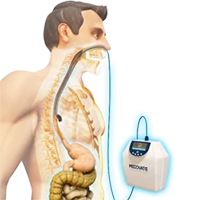About LUMEVAC™
Anastomotic leakage, a defect or hole in the GI tract, is a severe complication of esophagectomy and other procedures and is associated with prolonged stay in intensive care, a reduced quality of life, high costs and an increased mortality rate.[1] GI leakage into the chest, mediastinum and upper abdomen results in a significant sepsis a serious medical emergency that is fatal if not treated successfully.
Management is challenging, especially in patients with delayed presentation. Traditionally this involved a combination of surgery, radiological drainage and enteral stenting. Patients usually require multiple interventions to drain sepsis and achieve source control.
More recently surgeons have developed an alternative treatment strategy for this problem called Endoluminal Vacuum Therapy (EVT). While EVT has been shown to improve mortality rates compared to surgery [2] this treatment still needs improvement as it requires multiple technically difficult procedures under general anaesthesia in an operating theatre to be successful.
‘LUMEVAC, formerly known as ENDOVAC’.
[1] Verstegen, M.H.P., Bouwense, S.A.W., van Workum, F. et al. Management of intrathoracic and cervical anastomotic leakage after esophagectomy for esophageal cancer: a systematic review. World J Emerg Surg 14, 17 (2019). https://doi.org/10.1186/s13017-019-0235-4
[2] Schniewind, B., Schafmayer, C., Voehrs, G. et al. Endoscopic endoluminal vacuum therapy is superior to other regimens in managing anastomotic leakage after esophagectomy: a comparative retrospective study. Surg Endosc 27, 3883–3890 (2013). https://doi.org/10.1007/s00464-013-2998-0




